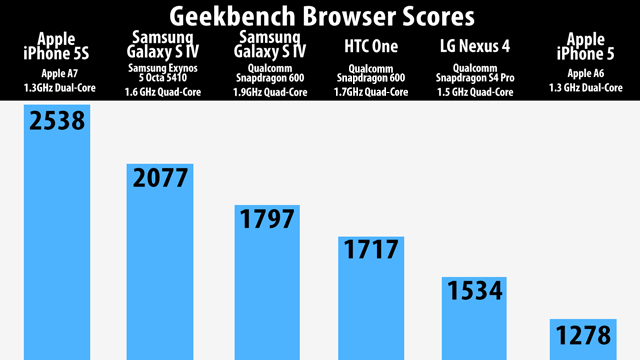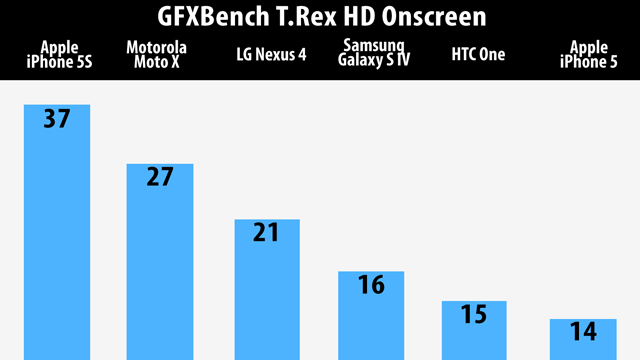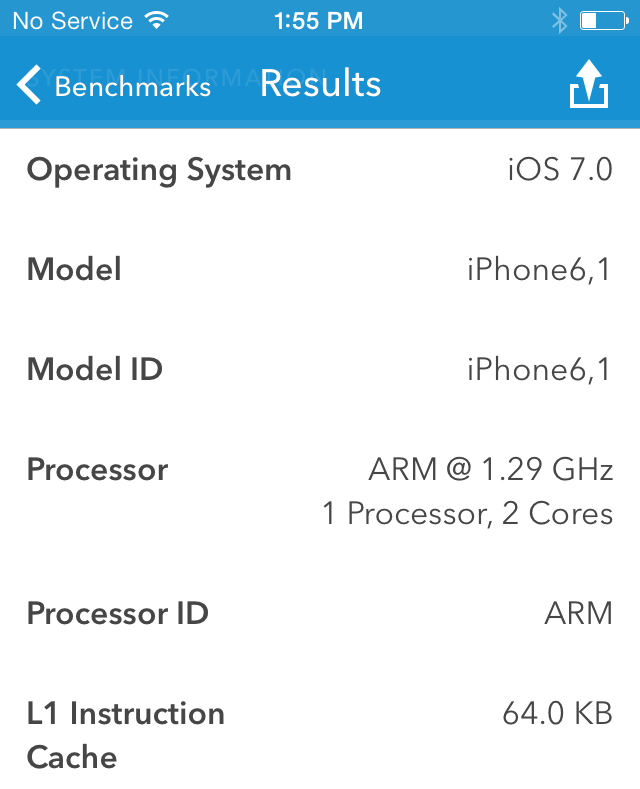We just ran benchmarks on Apple’s new iPhone 5s, revealing that, yup, this is the dopest smartphone silicon ever made. This thing freaking churns, crushing every other smartphone out there on both computational power and graphics. But if you look at common specs like core-count and clock speed for the hardware, you’d never know it.
By now it’s no mystery that specs aren’t the whole story. Intuitively, we know that the quality of a smartphone is just as reliant on its industrial design and the quality of the software it runs. But it goes deeper than that: the traditional “specs” distract us from what a gadget’s guts actually do, and from a technological point of view, they distract us from the advancements that are actually making a product better.
Apple’s iPhone design is a masterpiece, and iOS 7 shows that Apple’s got a mastery of operating systems as well, more or less. What’s not as well-known is that Apple’s a leader on guts as well. Here’s a look at what the guts can do and how Apple beat the pack.
The fastest chip ever

The benchmarks for Apple’s new iPhone 5s are absurd. After running Geekbench 3.0 on the hardware, we got scores that match up with the numbers reported by others, like those in AnandTech’s unbelievably thorough survey of key performance tests. Geekbench’s score is a nice measurement because its built from a combination of measurements of computational speed across a variety of real-world processes like JPG compression and decompression. The combined score for the iPhone 5s beats everything else you’d consider buying and even Samsung’s insane international version of the Galaxy S4.

The impressive results confirm many of the improvements Apple claimed in its early September keynote.
We ran the iPhone 5s’s GPU through the commonly used GFXBench software, using its most-intense on-screen gaming test and compared it to the publicly available leaderboards for existing flagships out there. The chart above the average frame rates the graphics processor of each phone. A faster rates in this test would translate to smoother graphics on the most system-taxing games out there.
And the iPhone’s graphics performance is spectacular: 37-frames per second, more than twice the iPhone 5’s 14 fps. It’a also significantly than the next-best US smartphone, the Motorola Moto X, which clocks in at 25 fps. In short, the iPhone 5s’s graphics powers are ready for the craziest games that’ll be coming out in the years to come.
These aren’t the only benchmarks out there, but they’re reflective of what nearly all tests are finding: The iPhone 5s has the best measured performance of any phone.
The truth about cores, clock speeds, and battery life

Now, if you compare this performance to the specs — unofficially, but dug up by Geekbench — you’ll be surprised. The A7’s dual-core ARM processor is clocked at 1.3 GHz. Only 1 GB of RAM. Consider that most of Apple’s competitors are running quad-core Snapdragon 600 processors, many of them, like the HTC One, clocked at up to 1.7 GHz. All of them pack 2 GB of RAM. What gives?
Here, we check back in with AnandTech, where Anand Shimpi drops knowledge. Turns out the specs we’re getting fed by manufacturers are a bunch of bull — or at least only tell a small fragment of the story. “I always thought the transition from 2 to 4 cores happened quicker in mobile than I had expected,” he begins, continuing later:
In such a thermally constrained environment, going quad-core only makes sense if you can properly power gate/turbo up when some cores are idle. I have yet to see any mobile SoC vendor (with the exception of Intel with Bay Trail) do this properly, so until we hit that point the optimal target is likely two cores.
In other words, the technology to efficiently power quad-core architecture in a smartphone while also taking advantage of extra cores doesn’t exist yet. So all that theoretical power is coming at waaaaaay too high a battery cost, or it would it anyone was crazy enough to try for it. And the muscle that is being used now is not as efficient as it should be.
Worse there’s a clock-speed war going on:
Then there’s the frequency discussion. Brian and I have long been hinting at the sort of ridiculous frequency/voltage combinations mobile SoC vendors have been shipping at for nothing more than marketing purposes. I remember ARM telling me the ideal target for a Cortex A15 core in a smartphone was 1.2GHz. Samsung’s Exynos 5410 stuck four Cortex A15s in a phone with a max clock of 1.6GHz. The 5420 increases that to 1.7GHz. The problem with frequency scaling alone is that it typically comes at the price of higher voltage. There’s a quadratic relationship between voltage and power consumption, so it’s quite possibly one of the worst ways to get more performance.
And here’s where we turn to another piece of the puzzle that isn’t covered in those benchmarks above: Battery life — the only spec that your should really read. You’ll notice that Apple’s A7 CPUs are clocked just above the 1.2 GHz sweet spot Anand describes. The core architecture and clock speed, are optimised for battery life. Consider that the iPhone 5’s 1440mAh battery had similar life to to the HTC One’s 2300 mAh battery.
Apple’s an early-adopter — of silicon design
So how is Apple getting much better performance than everyone else? With the iPhone 5’s A6, Apple turned to custom-designed chips with custom-designed cores based on ARM designs to improve results. With the A7, Apple continues this trend by adopting industry-leading technology.
So let’s turn to one spec Apple did announce on stage: The new 64-bit CPU, which replaces the 32-bit predecessor. This is the key, but not in the way you might think it is. As Anand and others point out, 64-bit transition doesn’t really start making a difference until Apple starts building phones with more than 4GB of RAM, which based on current trends, won’t happen for years.
The reason Apple’s 64-bit future-proofing matters today is that it requires Apple to adopt an entirely new underlying processor architecture. A7’s CPU ditches the 20-year-old foundation of the ARMv7 “instruction set” (ISA) , and goes with the ARMv8 design, which was released in 2011 and represents an entirely new system. As John Gruber notes, 20 years in the history of computing is an eternity. He points to a passage from the white paper describing ARMv8:
Of course, for compatibility reasons, we still support the entire ARMv7 machine in the new ARMv8 architecture, but when running 64-bit software, this part of the machine is not being used, and the area of complex legacy it had built up does not need to be active when running in the 64-bit ISA, unlike other architectures where 64-bit extension was simply added to the historical complexity and legacy of their 32-bit mode. The new ISA drew upon the years of experience of building different micro architecture implementations, so again it was defined so that these new processors can be more easily optimised for low power operation — an opportunity not really offered since the first ARMv4 machine that resulted in the now legendary low power ARM7 processors.
According to Gruber’s frequently reliable sources, switching to ARMv8 is responsible for a 15 to 20 per cent improvement in performance while simultaneously improving battery life.
Apple is the first to implement ARMv8, and it makes total sense that this newer technology is producing better results than the older technology. But you won’t see that show up on most spec sheets. Without going down another rabbit hole, it shouldn’t surprise you to learn that the new supercharged GPU owes its impressive performance to a GPU no one else has used yet.
Sometimes people like to harp on Apple for stagnating, but the company’s progress under the hood show that it’s just not true. For all the huge specs (and huge screens) Apple’s competitors like to throw around, Apple remains a year ahead on the only metric that really matters: How well the phone actually performs.
